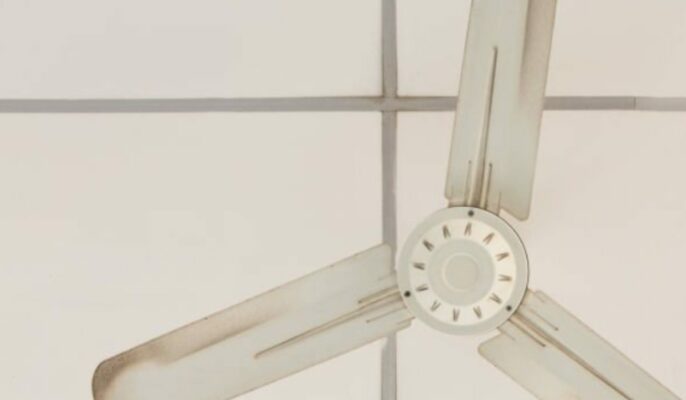Deep cleaning of home’s is a major task that is undertaken every once in a while. While it is essential to maintain optimal hygiene in your living space, it can often be exhausting and time-consuming. Moreover, if not done correctly and carefully, the results might be subpar. However, even while deep cleaning the space we often tend to overlook certain items, leading to accumulation of dirt on them that might affect their functionality. In this article, we will take a look at some such articles in your home that are easy to neglect and leave uncleaned.
See also: Tips and tricks to deep-cleaning your bathroom
Ceiling fans
While installing ceiling fans out of easy reach does away with a lot of safety concerns, it can be a disadvantage when it comes to maintenance and cleanliness. The blades tend to accumulate dust over time, which can get dispersed throughout the room as the fan operates, thereby affecting indoor air quality. It is crucial to clean the blades of your ceiling fans regularly to prevent dust buildup and ensure a healthier living environment.
Light fixtures
The maintenance and cleanliness requirements of light fixtures often get overshadowed by their functionality. Dust, dead insects and other debris, when accumulated in light fixtures, can significantly diminish the quality and brightness of the light. Cleaning the fixtures, alongside providing more efficient illumination, also prevents potential fire hazards from the accumulated dust.
Door knobs and handles
Coming in frequent contact with multiple people, door knobs and handles are hotspots for germs and bacteria. Not only do they breed germs, but also play a significant role in the spread of illness-causing germs. These spots must be regularly cleaned with disinfectant wipes or sprays to prevent the spread of such harmful pathogens and maintain a clean living environment.
Remote controls
While frequently used by various different pairs of hands, remote controls are often overlooked when it comes to cleaning. As a result, they can foster various bacteria and viruses, especially in households with multiple occupants. To keep the germs at bay and maintain optimal cleanliness, it is recommended to clean remote controls with disinfectant wipes.
Trash cans
Most households use separate liners in trash cans for ease of cleaning and disposing of the trash. Despite this, it is only normal for them to become dirty and smelly over time due to spills, leaks and food residue. Regular cleaning helps eliminate odours and maintain cleanliness. This can be done by cleaning and disinfecting with soap and water.
Behind appliances
While using appliances like refrigerators, stoves and washing machines, rarely do we check behind them for dirt. However, it is very common for dust and food debris to accumulate behind such appliances. Cleaning these inconspicuous areas not only improves appearance but also of the space but also prevents dust buildup that might attract pests and fester an unhealthy living environment and poor air quality.
Under furniture
Open areas under furniture like sofas and beds and prone to the accumulation of dust bunnies, pet hair and other debris. These, in turn, form the breeding grounds for various allergens. Make sure to regularly vacuum and clean these areas to keep these allergens at bay and maintain a cleaner living space.
Showerheads
Showerheads are commonly prone to the buildup of mineral deposits over time due to hard water, which can significantly affect the flow and pressure of water. Therefore, cleaning them regularly is essential to ensure a wholesome showering experience and optimal performance. To clean the showerhead, consider using vinegar or commercial descaling solutions that van easily remove the accumulated deposits.
Curtains and drapes
Curtains and drapes are easy traps for dust, allergens and pet dander if not regularly cleaned. Remove accumulated dirt from curtains and drapes by washing or dry cleaning, as recommended by the manufacturer, and maintain a healthy living environment in your home.
Baseboards
Since they are normally found in hard to reach areas, baseboards tend to collect dust, pet hair and debris over time. To remove the accumulated dust, it is recommended to clean the baseboards with a vacuum cleaner or damp cloth. This significantly improves the overall cleanliness of the room.
FAQs
How often should I clean ceiling fans?
While it is recommended to clean ceiling fans once every few months, the frequency may vary according to external conditions of the region and usage patterns of the fan.
Is it necessary to clean behind appliances like the refrigerator and stove?
Cleaning behind appliances regularly is necessary to prevent accumulation of dust and dirt that might invite pests.
How can I effectively clean light fixtures without damaging them?
Light fixtures can be easily cleaned using a soft cloth to remove loose debris. For deep cleaning, consider switching off the power and detaching the parts of the fixtures to clean separately and drying before reinstalling.
What's the best way to clean remote controls without damaging them?
Remote controls should be cleaned with disinfectant wipes or damp cloth while making sure that moisture doesn’t enter and damage its components.
How do I clean showerheads to remove mineral deposits?
Soak the showerhead in vinegar solution overnight and scrub it clean with a brush and rinse before reattaching to get rid of accumulated mineral deposits.
Why is it important to clean baseboards regularly?
Baseboards are prone to collect dust, pet hair and other debris over time that can deteriorate indoor air quality and affect the overall cleanliness of the room.
What's the most effective way to clean curtains and drapes?
Follow the fabric care instructions provided by the manufacturer on whether to wash or dry clean the curtains to avoid causing damage.
| Got any questions or point of view on our article? We would love to hear from you. Write to our Editor-in-Chief Jhumur Ghosh at jhumur.ghosh1@housing.com |
